- Home
- Deceptions
- Solar
- Thermal Audit
- Ventilation
- Sensors
- Governance
- Environment
- Reference
- Contact
- News
Voltage Control Guard or VCG1
AC neutral bus electromotive power rectification device
Update: Feb 2011
This page gets a fair bit of e-mail and many have asked where to report it so here are some links to important complaint forms. It is important to report every scam you find because with limited resources, those with the most complaints will be priortized for legal action.
National Consumers League’s Fraud Center (on-line complaint form)
Federal Trade Commission (on-line complaint form)
Georgia Atorney General (no e-mail address or form on the site, but you can fax it in)
Georgia Governor's Office of Consumer Protection (downloadable form to mail in)
Georgia Office of Consumer Affairs (on-line form for things that affect citizens in general)
Canadian Anti-Fraud Center (they share with US authorities)
FBI Tips (on-line form)
Update: October 2010 - Charles City County and Dominion Power of Virginia are getting tangled up in this scam. The meeting minutes are here. The board of supervisors present were Timothy W. Cotman, Gilbert A. Smith and Sherri M. Bowman. If you know them, please make sure they don't waste taxpayers monies on this stuff.
"County Administrator, John F. Miniclier, Jr., provided the Board of Supervisors an update on the Energy Savings Pilot Project facilitated by Dominion Virginia Power in the county beginning with Phase I in December, 2009, where nine (9) Gig2 units were installed. In April, 2010 Dominion decided to continue with funding an additional phase and we are currently in Phase II. They have installed approximately 35 units in individual homes and business breaker boxes. These homes and businesses use the Courthouse area as the base and are installed on Courthouse Road and The Glebe Lane, including the bank, the health clinic, the church, the restaurant, government buildings and residences."
As for Dominion Power -- for goodness sake, ask a few of your staff electrical engineers how a coil of wire connected to a grounded neutral bus could posibly save energy! Any competent electrical engineer can set you straight on that one.
The comment section at the end of the page has some new entries.
The GiG 2 web site claims savings of 15% to 28% in single phase applications (household power is single phase). I'd classify it as an unworkable device except that the sales pages lead consumers to believe that they will get substantial energy savings when the most likely improvement is exactly zero.
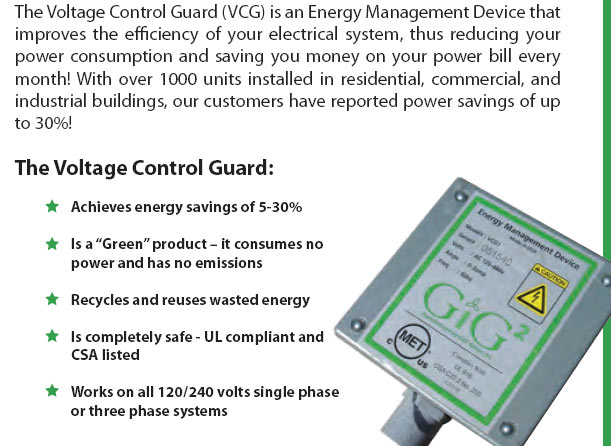
From the marketing material, we have the following claims:
The Voltage Control Guard is a revolutionary device that returns unused energy to proper phase and polarity on the neutral side, thus decreasing the over all demand within the system. It does not store or consume energy, and it has no moving parts, capacitors, or resistors. Additionally, the VCG does not require the use of surge suppressors or spike protection. ... we use no capacitors, resistors, surge protection, spike protection, or moving parts. Our technology is revolutionary and patented, it has been independently proven, third party tested and supported by substantial case study data and consumer testimonials to verify that our product provides the savings reflected in our literature.
"Returning unused energy" is nonsense. They statement that it does not store or consume energy is correct. Although it does contain a coil which could store energy, it cannot because both ends of it are grounded and therefore there is no voltage across it. There are indeed no capacitors, resistors or moving parts. There is glue, plastic pile, some copper wire and what looks like iron filings inside. It is a useless device.
Voltage Control Guard has a UL 916 rating and is approved by Met Labs. Additional third party testing was performed by an independent laboratory and achieved positive results. Independent lab tests are an ongoing part of our research and development.
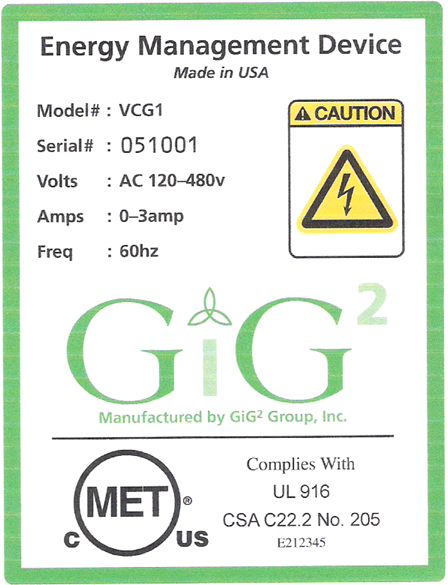

UL and CSA are only interested in product safety standards, like proper grounding and voltage leakage tests so that consumers are protected from hazards. This is not an endorsement that a product performs as claimed. Their white paper doesn't mention the names of the independent testing lab. The CSA marking on the unit appears to be CSA 22.2 No. 205 , which is a standard for the safety of signal equipment (buzzers, bells, energy management, nurse call etc.).
In single phase electrical installations we are seeing savings ranging from 15 to 28 percent reduction in daily KWH. This is not believable. These are huge savings.
we make no warranties of any kind, express or implied, and specifically disclaim, following the term of the limited warranty, any warranty of merchantability, fitness of the device for a particular purpose, ... That at least, seems like a good idea.
The Voltage Control Guard is not a surge protector or line conditioner nor does it need this equipment to function as designed. This is true. There are no capacitors inside, so it can't correct the power factor of motors, nor are there any surge supressor devices inside.
The site "Save Energy North Carolina" states in their voltage control guard FAQ "We are currently awaiting our Energy Star approval and rating" - It is going to be a long wait. EnergyStar does not approve products. They do have categories where you can "qualify" if you meet certain standards related to water and energy use -- such as a refrigerator that uses 15% less energy than the minimum Federal standards for refrigerators. Devices like these, even if they did work, have no product category and cannot carry the EneryStar label. See the official energystar site for current product categories -- you will see there is no category for things like this. note: GiG2 agrees that this statement is incorrect and does not appear on the gig2 web site although it is used by others to promote the product.
the Voltage Control Guard reduces consumption of energy across the spectrum of loads within any residential or commercial application. The highest savings is associated with inductive loads such as those found on motors, pumps, etc, including most heating and air conditioning equipment. This claim is based on their idea that electrical noise is being reclaimed and that motors would be source of this noise, as opposed to power factor correction.
Power factor testing was performed using the Extech 382905 on both three-phase and single phase systems with varying loads and real world power factors with and without the Voltage Control Guard One. No change was observed in the measured power factor when the Voltage Control Guard One was added to the circuit. - This is not surprising since they claim it is not a power factor correction unit, nor are there any capacitors inside. Additionally, it is shorted out by the neutral bus, so you would expect it to do nothing.
Example guarantee from a distributor ...
Purchase The VCG and have it installed by our licensed electrician.
- Monitor your energy usage over the next 90 days.
- Compare your usage (kilowatt hours) during the first 90 days to both the prior 90 days and the same period from the previous year.
- If you don’t realize at least a 5% savings in energy usage, we will uninstall the VCG and refund your
money. It’s that simple
- How do you know if I have saved energy?
To verify your energy usage and savings, we require that you share your historical billing information with us. You will need to provide us with your energy bills for first full 90 day billing cycle after installation of the VCG, the bills for the immediately preceding full 90 days billing cycle, and the energy bills from the same period in the previous year. With this information, we will be able to construct a 3 year usage trend and quantifiably determine in the form of a Savings Report if you have used less energy with the VCG. After receiving your billing statements, the Savings Report will be completed and sent to you within 10 business days. If the Saving Report shows that you have not experienced an energy savings, we will immediately contact you to schedule the un-installation of your VCG and provide you with a complete refund.
An article in ABC's WCPO.com states: "We contacted Duke Energy and the department of Electrical Engineering at the University of Cincinnati....to see what they knew about Save Energy Ohio's energy saving gadget. But neither Duke nor the head of UC's Engineering Department knew anything about it. Both examined the company's website, but said it doesn't say enough for them to understand how the device works."
Well Duke Energy and University of Cincinnati EE, you are pathetic. Call a spade, a spade. If they had asked you about a warp drive coil or a Klingon cloaking device, would you have said "you don't understand how it works", or would you have stated "it is a scam". At the least, you could have stated "there is no theory to support a device that claims it can reduce power bills by up to 25%". Get some balls.
Ok .. enough madness. As long as this device claims massive savings of 15%-28% without substantial proof e.g. tested by a reputable laboratory (perhaps Consumers Reports or a government research lab) to prove it works and the laws of physics are amended to explain the behavior, It will remain here in our deceptions series.
Reference material for the curious:
- The current company making these is GIG2 Group, Inc. website is www.gig2inc dot com
- The previous name of the company was CUTT-A-WATT Incorporated. The old sites are archived at http://web.archive.org/web/20030618020052/http://www.cutt-a-watt.com/index.html and a similar site is at http://web.archive.org/web/20071012135343/http://cawenterprises.com/index.php
Technical analysis
The VCG is intended to be connected in parallel with the neutral bar in the household electrical panel.
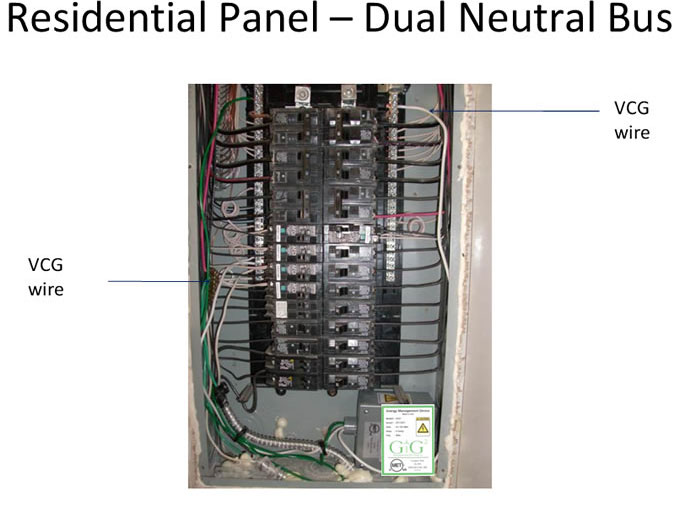
Internally, it consists of two coils in series, each made from about a 12 turns of 10 gauge wire. The coils are inserted into 2.5 inch lengths of PVC conduit, filled with metal filings and capped. The plastic caps are drilled so that the wire can exit. The diagram below is a crude representation of an electrical panel. The long rectangle is the "neutral bar" which is a block of heavy metal with holes and set screws. Wires are connected to the bus bar by inserting them into holes in the side of the bar and tightening a screw. Each circuit in the electrical panel (the 110 volt ones that go to wall sockets) has its hot wire connected to a circuit breaker while all the neutral wires are connected to the bus bar.
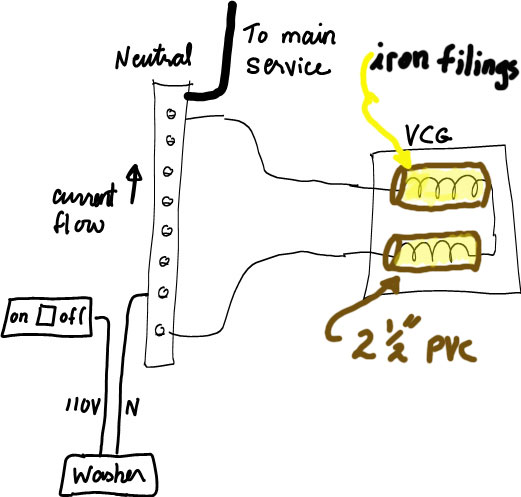
The neutral bar is also grounded to earth so the voltage measured between and earth is almost zero.
All things have electrical resistance (superconductivity aside), but the resistance of the heavy neutral bus bar is very small. If all the lights were on in the house as well as all your 110V appliances, the current travelling through the bus bar would result in a very tiny voltage drop from one end of the bar to the other due to the internal resistance of the bar. This voltage would be less than 1 millivolt. Adding the VCG to the circuit simply reduces the resistance of the resistance of the bar just a litte more. Of course you could achieve the same thing by using a larger electrical panel since larger panels have heavier and thicker bars to handle more wires. Lower resistance results in less heat loss in the bus bar but this "saving" would be absolutely negible in any residential setting. By negligible, I mean a penny a decade or worse. It should be obvious that there is nothing you can connect in parallel (effectively a short circuit) with the neutral (and grounded) bus bar that could possibly result in 5% to 30% energy savings.
Here is an analogy. You want to save on your water bill and are interested in the "miracle flush". You purchase it and a plumber comes to your home and installs an extra 1 inch pipe in parallel with your 4" sewer pipe. The toilet is supposed to now use less water to flush. The problem is that the toilet flushes a volume of water equal to the capacity of the flush box - so you achieved nothing. Same goes for electrical appliances -- if you turn on a 1000W hair dryer for an hour, you burn 1kWh of energy. It doesn't matter what you do to the sewer or bus bar, the hair dryer is not going to get hotter, blow harder or somehow use 30% less energy to dry your hair.
Here is a recent patent application with similar drawings from CUTT-A-WATT. The application is nonsense, and is not likely to be approved, although nonsense devices have been patented in the past. Here is their abstract:
"An AC neutral bus electromotive power rectification unit, comprising: a. a first coil unit, including a first conductive wire coil having a first end and an opposite second end, the conductive coil disposed in a first non-conductive tube and suspended in a ferrous matrix; and b. a second coil unit, including a second conductive wire coil having a first end and an opposite second end, the first end of the second coil unit being electrically coupled to the first end of the first coil unit, the second coil unit disposed in a second non-conductive tube and surrounded by a non-conductive material."
English translation of the above: "the first coil of copper wire (which is just the copper wire you use to wire up your wall sockets, wrapped around something the size of a finger about 14 times) is inside of a piece of plastic tubing (like PVC conduit or plastic water pipe from Home Depot) and filled with metal filings. A second coil, also in a plastic tube, is connected to the first one".
The real nonsense continues here. In particular, the phrase "electromotive power rectification" is nonsense. They are claiming:
"An AC neutral bus electromotive power rectification device for use with a neutral bus bar in an electrical power distribution box, in which a plurality of inside neutral wires are coupled to the neutral bus bar and in which one outside neutral wire is coupled to the neutral bus bar, comprising: a. a first coil unit, including a first conductive wire coil having a first end and an opposite second end, the conductive coil disposed in a first non-conductive tube and suspended in a ferrous matrix, the second end of the first coil unit electrically coupled to the neutral bus bar at a first position in which every neutral wire coupled to the neutral bus bar lies between the first position and a second position at which an outside neutral wire is coupled to the neutral bus bar; and b. a second coil unit, including a second conductive wire coil having a first end and an opposite second end, the first end of the second coil unit being electrically coupled to the first end of the first coil unit, the second coil unit disposed in a second non-conductive tube and surrounded by a non-conductive material, the second end of the second coil unit electrically coupled to the second position at which an outside neutral wire is coupled to the neutral bus bar. "
Here are the results of perfoming a circuit simulation with MultiSim (Multisim is a electrical and electronics simulation package from National Instruments that is widely used in industry and the academic community):
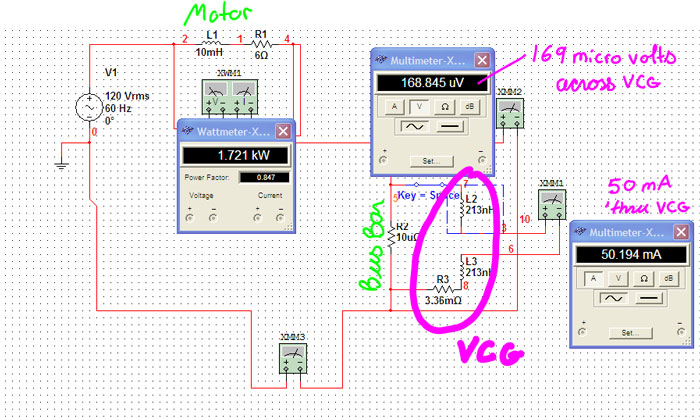
In the diagram above, V1 is set to 120VAC 60Hz (household voltage in North America). The section labeled motor is a resistance and inductor to emulate a 1700W motor on a circuit from a fuse box. The current that goes through the circuit passes through the heavy bus bar in the electrical panel. Because the resistance of the bus bar (a heavy metal bar with screw connectors) is so low, the voltage drop across it is only 169 millionths of a volt. The VCG is connected across this extremely low voltage. Inside the VCG, there are two coils with an inductance of approximately 213 nH and internal resistance of 2.2 milli Ohms. This is based on the properties of common copper wire. The box in the lower left shows that the current flowing through the VCG is 50 thousandth's of an ampere. Not only is this very little current, there is also very little voltage so you are looking at microwatts (millionths of a watt).
The end result of this is an infitesimal reduction in the heat loss through the buss bar due to the reduced resistance of having and extra wire in parallel with it.
Therefore the probabality that this could result in a significant reduction of your power bill is zero. Absolutely zero.
Feedback
I am an electrical contractor, that is: I have a contractors license, though I work for a company owned by others. Wanted to make a comment or two on the Gig2 device you have analyzed.
- Promotion of this product is especially strong in some areas. Anecdotal and unreliable reports state the reason for it's popularity here is that the wife of a local car dealership owner purchased controlling interest in the Gig2 company shortly after surviving a fraud trial involving the dealership. Her brother was "allegedly" convicted in this trial.
- Directly reported evidence from techs who have installed "many" of these state: The Gig2 company also promotes this product as being from a "religiously run corporation", the company self promotes, in a mildly humorous (supposedly) way: They refer to the device as the "Go In God" device. This seems to "relax" some of their potential clients.
- I had the very great misfortune to have to sit through a 1 hour long "internet orientation" to this device, given by an "electrical engineer". He claimed his degree was from Michigan, and ended the orientation within seconds of my asking that question.
- These devices are selling "like hotcakes" here based on the completely impossible claims you cite. At least one major national retail chain, with very educated and successful people in charge, has begun installing these units in their stores.
- The UL listings are hysterical. They are, from my (possibly flawed) research: Listings that affirm this device is "safe" when installed as intended. Of course, you could get the same listing on the average rock, as long as you didn't throw it at anyone. The device is certainly safe, as it performs no function whatsoever.
- The company repeatedly claims (or did claim, haven't checked recently)that getting the "formal" UL certification is "too complicated and expensive" at this time and that UL "does not have a category" into which this device can be "classified". Unless you count the thing with the rock....
I am in the (very unfortunate) position of being associated with sales of this item, in spite of my well reasoned objections and diagnosis of this to my employer. Largely this is because it is very easy to be confused by a product that makes no definable statement as to it's function or operating principles. Also: Business stinks and these are worth a few hundred dollars apiece per sale.
Eventually the extent of the "effectiveness" of this product is going to be widely recognized, and my comments could be construed as " counterproductive" to our organization.
I have successfully lobbied for one concession in my employment: I have asked to be excluded from direct sales of this item, and have the freedom to refer questions about this product to other staff members. I wouldn't call this a "moral victory", but at least it is something.
You are free to use any comments you wish in future print about this product (or just laugh at them).
Thank you for the article, I am glad to see this is beginning to be widely recognized, and hope it will quickly disappear.
"In regards to the GIG2 VCG1: I know someone who has done a controled test of this device and it proved to be worthless. It is not even worth the cost of materials used to make it. I have seen what is inside of it and doubt if costs this company more than $15.00 to biuld it. This is truly a scam and alot of people are being robbed.The peddlers of this product should be investigated."
"So, are you saying that they never offered to install the units for you for FREE? That is what I was told and that you refused. I thought that was a bit stupid because honestly if someone really had a unit that did work as said and a person would not take them up on it to prove them wrong - well I would have to question why."
Editor's note: That is correct. This is a story that GiG has been feeding to their distributors when they mention this web page.
"I'm an engineer working for the US DOE EERE Information Center and wondering if you have any additional technical information about this device. I read your explanation about the VCGI: http://www.nlcpr.com/Deceptions11.php, and am curious to see if you have tested it or know someone who has purchased it."
Anyone want to send their useless device to the US DOE EERE for evaluation? At least the DOE is beginning to take notice of the questionable claims.
get a lot of hate mail about this page ... most of it is too nasty to print, but here are a few of the milder/amusing ones:
You are nothing but a pathetic sceptic clutching straws. PRINT this!!! - S Carusos
If you are so smart why are you only a electrical contractor and not an engineer? And why won't you return any of gigi2's calls? - anonymous
Just wanted to add, energy star is a scam!you have been fooled i.e scammed. - Mr. Strassenburg
I work for an energy consulting company and we specialize in black-box analysis and "debunking." We always have to be careful and somewhat conservative in our analyses in order to avoid lawsuits (and sometimes we still get sued).
I definitely appreciate your efforts and I hope that someone with authority gives them a critical evaluation soon. When I called the phone number listed for GIG2, it was a fax number. I've got a call in to WAJA labs to see if they are actually willing to back this thing and/or make a definitive satement about how it operates to saves energy.
If there really was so much wild noise floating all over the neutral buss bar, I'm pretty sure it would be causing some interesting problems in our home appliances. What gets me is that they constantly reiterate that, if no energy savings are achieved, it's most likely the fault of the installer. Buncha assholes, huh?
Take care, and keep on keepin' on.
